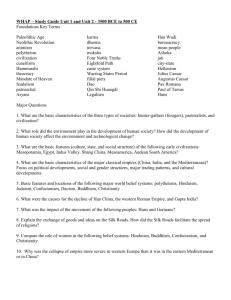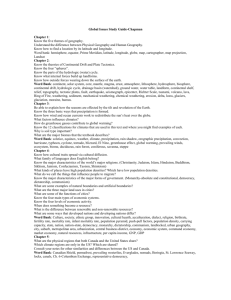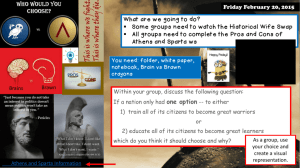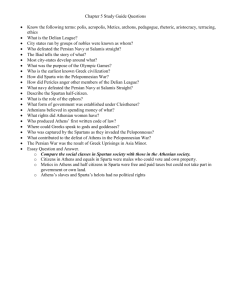World 10 Practice SOL
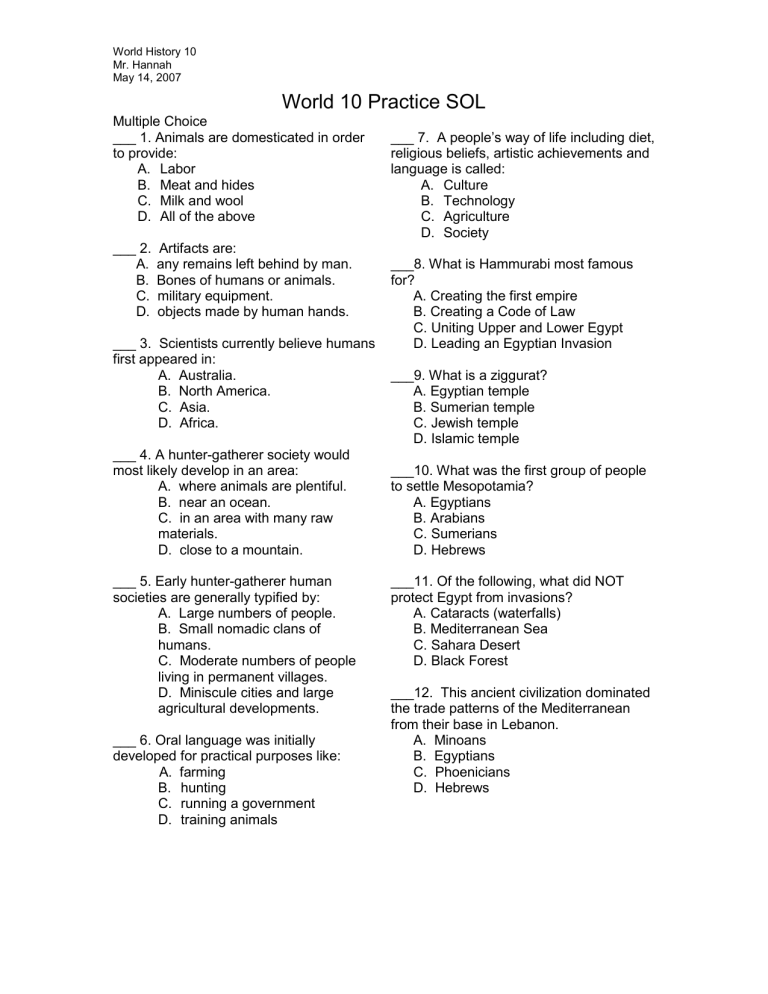
World History 10
Mr. Hannah
May 14, 2007
World 10 Practice SOL
Multiple Choice
___ 1. Animals are domesticated in order to provide:
A. Labor
B. Meat and hides
C. Milk and wool
D. All of the above
___ 2. Artifacts are:
A. any remains left behind by man.
B. Bones of humans or animals.
C. military equipment.
D. objects made by human hands.
___ 3. Scientists currently believe humans first appeared in:
A. Australia.
B. North America.
C. Asia.
D. Africa.
___ 7. A people’s way of life including diet, religious beliefs, artistic achievements and language is called:
A. Culture
B. Technology
C. Agriculture
D. Society
___8. What is Hammurabi most famous for?
A. Creating the first empire
B. Creating a Code of Law
C. Uniting Upper and Lower Egypt
D. Leading an Egyptian Invasion
___9. What is a ziggurat?
A. Egyptian temple
B. Sumerian temple
C. Jewish temple
D. Islamic temple
___ 4. A hunter-gatherer society would most likely develop in an area:
A. where animals are plentiful.
B. near an ocean.
C. in an area with many raw materials.
D. close to a mountain.
___ 5. Early hunter-gatherer human societies are generally typified by:
A. Large numbers of people.
B. Small nomadic clans of humans.
C. Moderate numbers of people living in permanent villages.
D. Miniscule cities and large agricultural developments.
___ 6. Oral language was initially developed for practical purposes like:
A. farming
B. hunting
C. running a government
D. training animals
___10. What was the first group of people to settle Mesopotamia?
A. Egyptians
B. Arabians
C. Sumerians
D. Hebrews
___11. Of the following, what did NOT protect Egypt from invasions?
A. Cataracts (waterfalls)
B. Mediterranean Sea
C. Sahara Desert
D. Black Forest
___12. This ancient civilization dominated the trade patterns of the Mediterranean from their base in Lebanon.
A. Minoans
B. Egyptians
C. Phoenicians
D. Hebrews
World History 10
Mr. Hannah
May 14, 2007
___13. The process by which people become more proficient at earning a living by performing a single task is referred to as:
A. Specialization
B. Cultural diffusion
C. Domestication
D. Urbanization
___14. The revolution where people left a nomadic life to farm the land and domesticate animals is called what?
A. Sumerian Revolution
B. Neolithic Revolution
C. Paleolithic Revolution
D. Autocratic Revolution
___15. The map above is showing which important trade route?
A. Silk Road
B. Straights of Hormuz
C. Tea Trading Route
D. Tran Siberian Road
___ 16. Where were the Hanging Gardens built?
A. Jerusalem
B. Carthage
C. Babylon
D. Sumer
___17. Who eventually invaded and conquered the Chaldeans?
A. Babylonians
B. Iraqis
C. Egyptians
D. Persians
___18. The great leader of Persia was named:
A. Cyrus
B. Nebuchadnezzar
C. Ashurbanipal
D. Cleisthenes
___19. The Chaldeans can also be called:
A. Persian
B. Assyrian
C. Babylonian
D. Hebrew
___20. This religion involved the belief in both a good and evil god fighting for influence on earth.
A. Islam
B. Zoroastrianism
C. Judaism
D. Hinduism
___21. Which belief system was NOT very important to the Chinese?
A. Confucianism
B. Hinduism
C. Daoism
D. Buddhism
___22. Chinese rulers validated their power with the:
A. Dynastic rights
B. Code of Bushido
C. Mandate of Heaven
D. Sword of Destiny
___23. Early Indian Civilizations were set on the Indus River and the:
A. Huang He River
B. Ganges River
C. Yangtze River
D. Tigris River
___24. The Golden Age for the Indian
Empire happens during which dynasty’s rule?
A. Gupta
B. Mauryan
C. Qin
D. T’ang
World History 10
Mr. Hannah
May 14, 2007
___25. Which of the following is a civilization that formed in the Indus River
Valley?
A. Harappa
B. Sumer
C. Cairo
D. Huang He
C. Development of imperial bureaucracy
D. Hinduism as a religion
___26. The above graphic represents the migration of __________ to India.
A. The Indo-Aryans
B. The Gupta
C. The Upanishads
D. The Shang
___27. Which of the following is a characteristic of Persian rulers?
A. Abuse of conquered people
B. Primitive transportation
___28. The following is a sacred writing of
Hinduism:
A. Ten Commandments
B. Code of Hammurabi
C. Upanishads
D. Koran
___29. What is the system of government where only a few wealthy people have all the power?
A. Democracy
B. Feudalism
C. Anarchy
D. Aristocracy
___30. In Ancient Greece, where was the most famous oracle located?
A. Athens
B. Sparta
C. Delphi
D. Troy
___31. What major contribution did Draco make to Athens?
A. Increased trade
B. Made 1 st legal code
C. Strengthened democracy
D. Created the Assembly
___32. What city-state controlled the
Delian League?
A. Venice
B. Sparta
C. Delphi
D. Athens
___33. Which war unites Athens and
Sparta?
A. Persian War
B. Peloponnesian War
C. Trojan War
D. Zulu War
____34. Which geographic territory do the
Greeks gain after victory in the Persian
War?
A. Sicily
B. Mediterranean Sea
C. Aegean Sea
D. Persia
____35. In contra st to Athens’ culture, the main focus of Spartan society was:
A. Education
B. Trading
C. Philosophy/Literature
D. Military
____36. What man made major reforms to
Athens including canceling all debts and ending slavery?
A. Cleisthenes
B. Draco
C. Pericles
D. Solon
World History 10
Mr. Hannah
May 14, 2007
___37. Who eventually won the
Peloponnesian War?
A. Athens
B. Sparta
C. Persia
D. Peloponnesus
___38. Why was the Parthenon built?
A. Pay honor to Athena
B. As a center for the government
C. As a military base for the army
D. As a lookout in Athens
___39. This war will leave the Greek citystates weak, broken up, and vulnerable to attack from outsiders:
A. Persian War
B. Peloponnesian War
C. Trojan War
D. Zulu War
___40. The Roman Empire lies in the center of which sea basin?
A. Aegean
B. Adriatic
C. Ionian
D. Mediterranean
___41. Rome is located on which river?
A. Tiber
B. Tigris
C. Euphrates
D. Ganges
___42. What document did the plebeians successfully force the patricians to sign?
A. Ten Commandments
B. Bill of Rights
C. Constitution
D. Twelve Tables
___43. Which of the following architectural buildings were NOT constructed in Rome:
A. Pantheon
B. Colosseum
C. Parthenon
D. Forum
___44. What event signals the end of the
Pax Romana?
A. Constantine taking the throne
B. Theodosius outlawing other religions
C. Death of Marcus Aurelius
D. Punic Wars
___45. The military became weak towards the end for which of the following reasons:
A. their technology was outdated.
B. the Romans started having to hire outsiders to serve in the military.
C. they focused too much on securing Rome.
D. they could not win the big one.
___46. Byzantium will be renamed to:
A. Constantinople
B. Istanbul
C. New Rome
D. Baghdad
___47. The language that the Romans spoke was:
A. Spanish
B. Latin
C. French
D. Italian
___48. This structure was used to appease and entertain the poor masses:
A. the temple of Jupiter
B. the Pantheon
C. the Forum
D. the Colosseum
___49. The Roman language is the basis of a group of languages called the ______ languages.
A. Romantic
B. Cyrillic
C. Germanic
D. Slovak
World History 10
Mr. Hannah
May 14, 2007
___50. Which of the following is NOT an aspect of the Pax Romana?
A. Expansion and solidification of the empire.
B. Relative peace for nearly 2 centuries.
C. A clear and bloodless succession of emperors.
D. It was created by Augustus
Caesar.
___51. What is another name for the first four books of the New Testament?
A. Bible
B. Gospels
C. Hymns
D. Apostles
___52. This architectural innovation supported more weight allowing structures to become larger and heavier.
A. Aqueduct
B. Corinthian Columns
C. Pulleys
D. Arches
___53. Emperor Constantine issued this declaring Christianity legal in the Roman
Empire?
A. Christian doctrine
B. Edict of Milan
C. Magna Carta of Carthage
D. Pax Romana
___54. What was created to carry clean water into the cities from the seas?
A. Aqueducts
B. Rivers
C. Canals
D. Water sprinklers
___55. Which religion placed a large emphasis on the respect of elders and on the worship of ancestors?
A. Confucianism
B. Taoism
C. Judaism
D. Buddhism
___56. Which religion is most focused on harmony with nature?
A. Confucianism
B. Taoism
C. Judaism
D. Zoroastrianism
___57. The Eightfold Path and Four Noble
Truths are guidelines of what religion?
A. Confucianism
B. Buddhism
C. Taoism
D. Islam
___58. Which two of the following religions began in India?
A. Hinduism and Buddhism
B. Taoism and Confucianism
C. Taoism and Buddhism
D. Judaism and Taoism
___59. Which religion began in modern day Iran?
A. Buddhism
B. Confucianism
C. Zoroastrianism
D. Taoism
___60. Mauryan (Indian dynasty) king
Asoka is most famous for spreading which religion?
A. Buddhism
B. Confucianism
C. Hinduism
D. Taoism
World History 10
Mr. Hannah
May 14, 2007
1.D
2.D
3.D
4.A
5.B
6.B
7.A
8.B
9.B
10.C
11.D
12.C
13.A
14.B
15.A
16.C
17.D
18.A
19.C
20.B
Key for SOL Practice Exam
21.B
22.C
23.B
24.A
25.A
26.A
27.D
28.C
29.D
30.C
31.B
32.D
33.A
34.C
35.D
36.D
37.B
38.A
39.B
40.D
41.A
42.D
43.C
44.C
45.B
46.A
47.B
48.D
49.A
50.C
51.B
52.D
53.B
54.A
55.A
56.B
57.B
58.A
59.C
60.A
